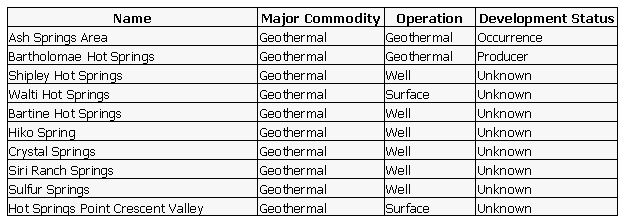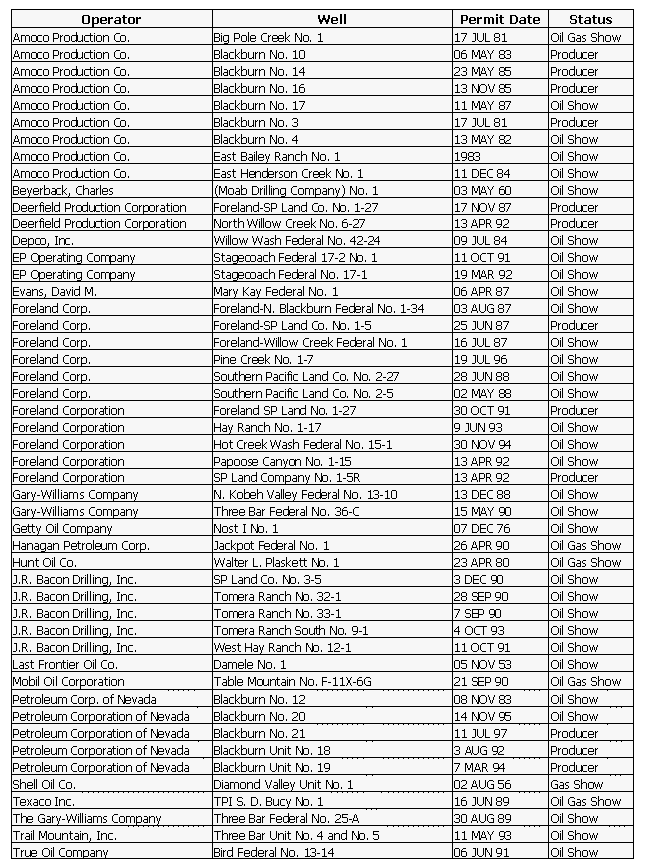3. MINERAL RESOURCE OCCURRENCES - Continued
 3.3.1 Geothermal Resources 3.3.1 Geothermal Resources
Green and sustainable power is becoming an increasingly important resource in the United States. In fact legislation is being passed at the State and Federal level mandating increased us of green energy. Large user states that lack resources for green energy look to other states with sustainable resources to purchase their power. A major source of green energy is geothermal resources.
Geothermal energy resources are underground reservoirs of heat usually associated with magmatic intrusions into subsurface rock layers. However, Eureka County is located in the Great Basin, where there are two types of recognized geothermal systems: Magmatically-induced systems as described above, and extensional fault systems associated with regionally high heat flow, and active faulting.
Groundwater circulating at depth in rocks heated either by magma or by the stress and strain resulting from extensional systems can be used as a medium to transfer heat to the surface to be used either directly for heating buildings or converted into electricity. Geothermal energy resources are considered to be renewable.
Generating electricity with geothermal energy requires very hot water generally found at greater depths below the surface. The technology used to generate electricity from hydrothermal fluids depends on the state of the fluid (whether steam or water) and its temperature.
There are three types of geothermal-powered electrical generation plants operating today, each of which ultimately employs steam to drive a turbine. Power plants within the Eureka County are all binary systems. In the binary system, the water from the geothermal reservoir is used to heat another "working fluid" which is vaporized and used to turn the turbine/generator units. The geothermal water and the "working fluid" are each confined in separate circulating systems or "closed loops" and never come in contact with each other. The advantage of the Binary Cycle plant is that they can operate with lower temperature waters (225° F - 360° F), by using working fluids that have an even lower boiling point than water. They also produce no air emissions.
Geothermal water that is not hot enough for electrical generation may be used for general building heating or for other purposes such as growing plants, dehydrating vegetables, fish farming, spas, recreational hot springs, swimming pools, etc.
 Existing Fields and Development of Resources Existing Fields and Development of Resources
Geothermal and hot spring occurrences are present in Figure 3.1.5. Electrical power is currently produced in the Beowawe geothermal area at the Oxbow geothermal power plant, which came online in 1985. Although the plant itself is immediately over the County line in adjacent Lander County, the geothermal resources used to power the plant come from both Eureka and Lander Counties. In 2005 electrical production from the Oxbow plant was 87,042 Megawatt hours. Table 3.3.1 presents the geothermal resources in Eureka County.
Table 3.3.1: Geothermal Resources

 3.3.2 Oil and Gas 3.3.2 Oil and Gas
An oil and gas lease grants the right to explore, extract, remove, and dispose of oil and gas resources that may be found in the leased BLM lands. Lease rights are controlled by standard lease terms and may be subject to particular lease stipulations (restrictions to further protect other resources) and other permit approval requirements based on a NEPA analysis of proposed disturbances and cumulative impacts.
Stipulations and permit requirements describe how lease rights are modified. The lease stipulations and permit conditions of approval allow for management of federal oil and gas resources while giving due consideration to other resources and land uses.
Exploration Drilling — Historically, there has been several exploratory wells drilled in Eureka County in the sedimentary formations. The most current information (Price and Meeuwig, 2006) indicates there was one oil exploration well drilled during 2005 in Eureka County at Tomera Ranch.
Leasing — Several oil and gas wells are present in Eureka County as shown on Figure 3.1.5. There are three active oil fields in Eureka County. These active fields are the Blackburn Field, North Willow Creek Field, and Tomera Ranch Field. These fields are near Nevada Highway 278, located in Pine Valley. Table 3.3.2 presents the oil and gas resources in Eureka County.
Table 3.3.2: Oil and Gas Resources

 3.4 Other Mineral Resources 3.4 Other Mineral Resources
 3.4.1 Paleontological Resources 3.4.1 Paleontological Resources
There are several valuable Paleontological resources are present within Eureka County. The Roberts Mountain Allochthon (or Thrust) extends north-south crossing Eureka County and contains windows (erosional holes in the allochthon) that allow viewing of the autochthon (rock beneath the allochthon). This classical geologic area provides paleontological specimens ranging from large to small used for display and scientific purposes. Locations of paleontological resources within Eureka County are indicated on Figure 3.1.5a.
The Roberts Mountain, Monitor Range, and Lone Mountain have been an important resource in the study of Late Ordovician period mass extinction according to Finney (1999). The Late Ordovician mass extinction was the second greatest of five large prehistoric mass extinctions. Eureka County contains an exceptional record of the Late Ordovician mass extinction in three sedimentary successions.
This Eureka County records are uniquely complete compared to other locations in the world and include distinct sedimentological signals of sea-level changes, abundant fossils, and well preserved carbon profiles. This allows unparalleled opportunity for scientists to assess associations between glaciation, extinction and disruption of the carbon cycles.
The Simpson Park Range (Red Hill area) and Roberts Mountains has produced a number of Devonian period vertebrate fish fossils along with marine invertebrates. Turner (1988) states the fossil specimens discovered include dipnoans, acanthodians, arthrodires, antiarchs, and crossopterygians.
|

